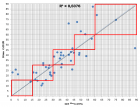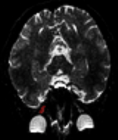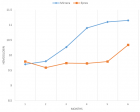Abstract
Review Article
Pseudoephedrine protects mice from infection of H1N1 virus
Zhongping Wu*, Li Deng, Chengzhi Chu and Xiaoyin Chen*
Published: 28 February, 2020 | Volume 4 - Issue 1 | Pages: 014-020
Ephedra, an ancient herb, is applied to treat common cold and influenza for such a long time in China. Pseudoephedrine is a main active ingredient from Ephedra which is used for relieving nasal congestion clinically. We previously reported that pseudoephedrine showed a potent anti-inflammatory effect other than sympathomimetic effects. In the present study, we aimed to investigate whether pseudoephedrine could protect mice from the H1N1 virus infection. The mice were infected with a 20% LD50 influenza A virus (IAV) suspension via intranasal administration to establish a virus infection model. Further, the mice were orally administered pseudoephedrine or oseltamivir for 4 days from one day after infection. Our results showed that pseudoephedrine improved lung pathological damage during the IVA infection period, and it dramatically increased the survival rate and attenuated loss of body weight compared with the virus-infected control group. In addition, pseudoephedrine inhibited the cytokine storms and mRNAs expression of the TLR7 signaling pathway. Surprisingly, pseudoephedrine showed an inhibitory effect on the replication of IAV. These results give clear evidence that pseudoephedrine is a potential anti-influenza drug by blunting cytokine storms and inhibition of replication of IAV, and following these results, we speculate that it should be tested in the novel coronavirus pneumonia (COVID-19, a severe epidemic in China currently) in which the cytokine storms play a key role to damage bronchi and lung in the early stage.
Read Full Article HTML DOI: 10.29328/journal.ijcv.1001008 Cite this Article Read Full Article PDF
Keywords:
Pseudoephedrine; Influenza A virus; Cytokine storm; Replication of influenza a virus
References
- Kmietowicz Z. WHO downgrades oseltamivir on drugs list after reviewing evidence. BMJ. 2017; 357: j2841. PubMed: https://www.ncbi.nlm.nih.gov/pubmed/28607038
- Wang C, Cao B, Liu QQ, Zou ZQ, Liang ZA, et al. Oseltamivir compared with the Chinese raditional therapy maxingshigan-yinqiaosan in the treatment of H1N1 influenza: a randomized trial. Ann Intern Med. 2011; 155: 217-225. PubMed: https://www.ncbi.nlm.nih.gov/pubmed/21844547
- Wu Z, Kong X, Zhang T, Ye J, Fang Z, et al. Pseudoephedrine/ephedrine shows potent anti-inflammatory activity against TNF-α-mediated acute liver failure induced by lipopolysaccharide/d-galactosamine. Eur J Pharmacol. 2014; 724: 112-121. PubMed: https://www.ncbi.nlm.nih.gov/pubmed/24365491
- Gelotte CK, Albrecht HH, Hynson J, Gallagher V. A Multicenter, Randomized, Placebo-Controlled Study of Pseudoephedrine for the Temporary Relief of Nasal Congestion in Children with the Common Cold. J Clin Pharmacol. 2019; 59: 1573-1583. PubMed: https://www.ncbi.nlm.nih.gov/pubmed/31274197
- Marathe BM, Mostafa HH, Vogel P, Pascua PNQ, Jones JC, et al. A pharmacologically immunosuppressed mouse model for assessing influenza B virus pathogenicity and oseltamivir treatment. Antiviral Res. 2017; 148: 20-31. PubMed: https://www.ncbi.nlm.nih.gov/pubmed/29100887
- Lee DW, Gardner R, Porter DL, Louis CU, Ahmed N, et al. Current concepts in the diagnosis and management of cytokine release syndrome. Blood. 2014; 124: 188-195. PubMed: https://www.ncbi.nlm.nih.gov/pubmed/24876563
- Teijaro JR, Walsh KB, Rice S, Rosen H, Oldstone MB. Mapping the innate signaling cascade essential for cytokine storm during influenza virus infection. Proc Natl Acad Sci U S A. 2014; 111: 3799-3804. PubMed: https://www.ncbi.nlm.nih.gov/pubmed/24572573
- Richman DD, Whitley RJ, Hayden FG. Clinical Virology. Third Edition ed. 2009.
- Han Y, Zhu J, Wu Z. Ephedra protects rats against acute liver failure induced by D-galactosamine and lipopolysaccharide. Zhonghua Gan Zang Bing Za Zhi. 2016; 24: 127-129. PubMed: https://www.ncbi.nlm.nih.gov/pubmed/26983481
- Jacobs JL, Coyne CB. Mechanisms of MAVS regulation at the mitochondrial membrane. J Mol Biol. 2013; 425: 5009-5019. PubMed: https://www.ncbi.nlm.nih.gov/pubmed/24120683
- Lee WS, Hsu CY, Wang PL, Huang CY, Chang CH, et al. Identification and characterization of the nuclear import and export signals of the mammalian Ste20-like protein kinase 3. FEBS Lett. 2004; 572: 0-45. PubMed: https://www.ncbi.nlm.nih.gov/pubmed/15304321
- Cao S, Liu X, Yu M, Li J, Jia X, et al. A nuclear export signal in the matrix protein of Influenza A virus is required for efficient virus replication. J Virol. 2012; 86: 4883-4891. PubMed: https://www.ncbi.nlm.nih.gov/pubmed/22345442
- Feng E, Ye D, Li J, Zhang D, Wang J, et al. Recent advances in neuraminidase inhibitor development as anti-influenza drugs. Chem Med Chem. 2012; 7: 1527-1536. PubMed: https://www.ncbi.nlm.nih.gov/pubmed/22807317
- Dickerson J, Perrier D, Mayersohn M, Bressler R. Dose tolerance and pharmacokinetic studies of L (+) pseudoephedrine capsules in man. Eur J Clin Pharmacol. 1978; 14: 253-259. PubMed: https://www.ncbi.nlm.nih.gov/pubmed/729619
- Rang H, Henderson G, Flower R, Ritter J. Rang & Dale's Pharmacology. Elsevier Health Sciences. 2007.
- Tetro JA. Is COVID-19 Receiving ADE from Other Coronaviruses? Microbes Infect. 2020.
Figures:

Figure 1
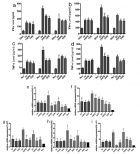
Figure 2
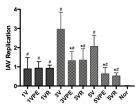
Figure 3
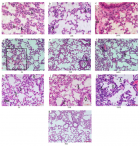
Figure 4
Similar Articles
-
Pseudoephedrine protects mice from infection of H1N1 virusZhongping Wu*,Li Deng,Chengzhi Chu,Xiaoyin Chen*. Pseudoephedrine protects mice from infection of H1N1 virus. . 2020 doi: 10.29328/journal.ijcv.1001008; 4: 014-020
-
Exploring pathophysiology of COVID-19 infection: Faux espoir and dormant therapeutic optionsVinod Nikhra*. Exploring pathophysiology of COVID-19 infection: Faux espoir and dormant therapeutic options. . 2020 doi: 10.29328/journal.ijcv.1001013; 4: 034-040
-
COVID-19: Targeting the cytokine storm via cholinergic anti-inflammatory (Pyridostigmine)Ahmed H Osman*. COVID-19: Targeting the cytokine storm via cholinergic anti-inflammatory (Pyridostigmine). . 2020 doi: 10.29328/journal.ijcv.1001014; 4: 041-046
Recently Viewed
-
The Lived Experiences of Addiction Counselors and Applications for Building ResiliencyBrian N Paulson*, Amy L Hayes, Stacey C Lilley, Brad A Imhoff, Charlotte A Crosland*. The Lived Experiences of Addiction Counselors and Applications for Building Resiliency. J Addict Ther Res. 2024: doi: 10.29328/journal.jatr.1001031; 8: 024-034
-
Loneliness and Culture: A CommentaryAmi Rokach*. Loneliness and Culture: A Commentary. Arch Psychiatr Ment Health. 2024: doi: 10.29328/journal.apmh.1001053; 8: 029-031
-
Hospitalization, Surgery and lonelinessKarishma Patel,Ami Rokach*. Hospitalization, Surgery and loneliness. Arch Psychiatr Ment Health. 2024: doi: 10.29328/journal.apmh.1001049; 8: 001-007
-
Schizoaffective Disorder in an Individual with Mowat-Wilson Syndrome (MWS)Yadwinder Chuhan, Nimrit Bath, Muhammad Ayub*. Schizoaffective Disorder in an Individual with Mowat-Wilson Syndrome (MWS). Arch Psychiatr Ment Health. 2024: doi: 10.29328/journal.apmh.1001050; 8: 008-011
-
Mapping the Psychosocial: Introducing a Standardised System to Improve Psychosocial Understanding within Mental HealthMatthew Bretton Oakes*. Mapping the Psychosocial: Introducing a Standardised System to Improve Psychosocial Understanding within Mental Health. Arch Psychiatr Ment Health. 2024: doi: 10.29328/journal.apmh.1001051; 8: 012-019
Most Viewed
-
Evaluation of Biostimulants Based on Recovered Protein Hydrolysates from Animal By-products as Plant Growth EnhancersH Pérez-Aguilar*, M Lacruz-Asaro, F Arán-Ais. Evaluation of Biostimulants Based on Recovered Protein Hydrolysates from Animal By-products as Plant Growth Enhancers. J Plant Sci Phytopathol. 2023 doi: 10.29328/journal.jpsp.1001104; 7: 042-047
-
Sinonasal Myxoma Extending into the Orbit in a 4-Year Old: A Case PresentationJulian A Purrinos*, Ramzi Younis. Sinonasal Myxoma Extending into the Orbit in a 4-Year Old: A Case Presentation. Arch Case Rep. 2024 doi: 10.29328/journal.acr.1001099; 8: 075-077
-
Feasibility study of magnetic sensing for detecting single-neuron action potentialsDenis Tonini,Kai Wu,Renata Saha,Jian-Ping Wang*. Feasibility study of magnetic sensing for detecting single-neuron action potentials. Ann Biomed Sci Eng. 2022 doi: 10.29328/journal.abse.1001018; 6: 019-029
-
Pediatric Dysgerminoma: Unveiling a Rare Ovarian TumorFaten Limaiem*, Khalil Saffar, Ahmed Halouani. Pediatric Dysgerminoma: Unveiling a Rare Ovarian Tumor. Arch Case Rep. 2024 doi: 10.29328/journal.acr.1001087; 8: 010-013
-
Physical activity can change the physiological and psychological circumstances during COVID-19 pandemic: A narrative reviewKhashayar Maroufi*. Physical activity can change the physiological and psychological circumstances during COVID-19 pandemic: A narrative review. J Sports Med Ther. 2021 doi: 10.29328/journal.jsmt.1001051; 6: 001-007

HSPI: We're glad you're here. Please click "create a new Query" if you are a new visitor to our website and need further information from us.
If you are already a member of our network and need to keep track of any developments regarding a question you have already submitted, click "take me to my Query."








